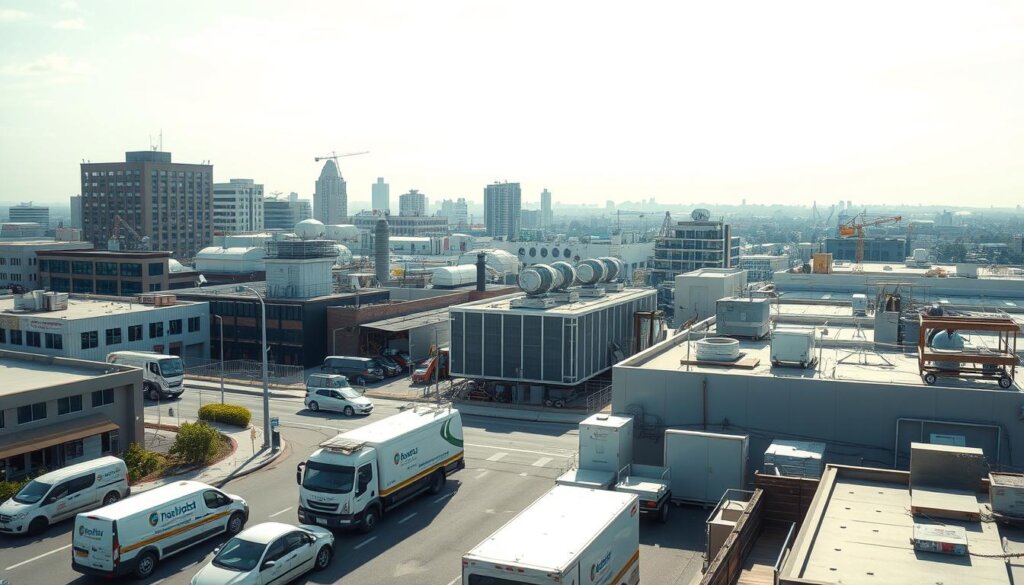Did you know that scheduling major purchases in fall or early spring can cut total costs by as much as 20% thanks to lower demand and faster installs?
I wrote this quarterly checklist so facility managers can keep their systems running smoothly while staying within real budgets today. I lay out practical steps I use to protect the building, improve comfort, and support business goals without sacrificing quality.
My approach mixes proactive services, clear documentation, and follow-through. I explain how timing work outside peak periods saves money and shortens turnaround time. I also show what to look for when comparing at least three quotes so you get apples-to-apples proposals that match your needs.
I preview the technical checks I perform on air handling, refrigeration circuits, electrical components, and controls. By turning findings into actionable solutions and repairs, I help extend system life and cut total cost of ownership.

Key Takeaways
- Plan purchases in off-peak seasons to save time and money.
- Keep a disciplined quarterly maintenance rhythm to protect assets.
- Compare at least three similarly formatted quotes before buying.
- Document checks on air, refrigeration, electrical, and controls.
- Translate inspections into prioritized, cost-saving solutions.
How I keep commercial HVAC systems reliable and efficient, season after season
With a data-driven schedule, I balance performance, cost, and occupant comfort across every building I service.
I start with a plan tailored to each building, mapping seasonal priorities so every system gets the right maintenance at the right time. I time major purchases and installs in fall or early spring to secure better pricing and faster scheduling.
I verify airflow and heat transfer fundamentals because reliable heating and cooling begin with correct air volume, clean coils, and proper refrigerant management. I document readings and compare them to baselines so small variances get fixed before they grow.
I match service intervals to brand and model needs and coordinate with your team to limit occupant impact. With my years of experience, I sequence rooftop and mechanical-room tasks to avoid peak-season disruptions and extra costs.
Before any project, I recommend getting at least three comparable quotes and checking brand reputations and installer capabilities. I deliver clear, quality-driven recommendations so you can weigh quick fixes against longer-term capital planning.
My quarterly Commercial HVAC maintenance checklist for your building
Each quarter I run a focused inspection that targets the components most likely to cause downtime or energy waste. I document baselines and trend data so we can spot declines early and plan repairs or replacements before they become costly.

Air filters and airflow
I replace filters to the correct MERV rating, check gaskets, and verify external static pressure. Proper air flow protects fans and downstream equipment.
Belt tension, pulleys, and vibration
I inspect belts, pulleys, and bearings and correct misalignment to reduce wear and noise that shorten part life.
Coils, condensate, and heat transfer
I clean coils, confirm delta-T across heat exchangers, clear drains, and sanitize pans to prevent biofilm and water damage.
Electrical, controls, and refrigerant
I tighten lugs, test capacitors and contactors, calibrate sensors, and trend BMS data. I also check superheat/subcooling and look for leaks to keep charge in spec.
Documentation and next steps
I tag assets, record runtime and readings, note immediate fixes and deferred repairs, and prioritize recommendations so technicians can act fast.
Why proactive maintenance pays off for my business
A disciplined maintenance plan turns small fixes into long-term savings for my business.
Energy savings and extended equipment life
I keep coils clean, airflow balanced, and controls calibrated so the system uses less energy. That lowers utility bills and reduces wear on motors and compressors.
Addressing small variances early prevents major failures and can extend equipment life by years. Trend data helps me time replacements on my terms.
Better comfort, fewer issues, and more productivity
Stable indoor conditions cut hot/cold complaints and reduce absenteeism. Fewer service calls mean staff stay focused and buildings run smoothly.
I compare the cost of a planned visit to emergency repair costs to show how scheduled care reduces risk and unplanned downtime.
With years of experience, I use consistent processes and clear documentation. Companies that invest in proactive programs see steadier budgets and higher occupant satisfaction scores.
Commercial HVAC services I provide: installation, repair, replacement, and maintenance
I deliver turn‑key projects and rapid repairs that match each building’s technical needs and budget.
I handle full installations and retrofits, from load calculations and design to startup and commissioning. I tailor each installation so the new equipment fits existing hvac systems and your budget.
Fast, reliable repairs
I provide quick repair service for critical heating and cooling issues. My technicians troubleshoot methodically so fixes last and avoid repeat calls.
Planned replacement and upgrades
I plan system replacement to improve efficiency and controls. I specify brands that balance lifecycle cost, availability, and serviceability and explain model-specific installation considerations.
Preventative maintenance built for uptime
My preventative maintenance includes documented checklists, performance readings, and prioritized recommendations. I also advise off‑peak scheduling—fall or early spring—to lower cost and shorten project timelines.
I coordinate permits, cranes, rigging, and safe rooftop access so your team can stay focused on operations. I offer flexible hvac services—from on‑demand repair to comprehensive programs—so you choose the right level for your facility.
Smart timing, quotes, and budgeting for HVAC service
I schedule big work in shoulder seasons to cut cost and wait time. Buying or installing during the hottest or coldest months drives up price because demand spikes. Fall and early spring usually give better pricing and faster installation windows.
I review at least three similarly formatted quotes so you can compare labor, materials, warranties, and lead times fairly. I scope each proposal to match your building needs and avoid surprises.
How I protect your budget and schedule
I discuss payment options, including whether a company accepts cash, since avoiding card fees can lower total cost today. I also set a realistic installation timeline with clear milestones so time aligns with your fiscal plan.
I plan contingencies for repair findings discovered during service and flag long‑lead parts early. Finally, I summarize total cost of ownership so you can weigh upfront savings against lifecycle value.
Commercial HVAC service areas I cover and how quickly I can get there
When a building needs attention, I mobilize nearby technicians to limit disruption and restore comfort fast.

Harford County
I’m local to Maryland and regularly serve Bel Air, Fallston, Forest Hill, Jarrettsville, and Sparks. I keep teams staged to reduce travel time for scheduled service and repair calls.
Baltimore County
I quickly mobilize in Towson, Owings Mills, Dundalk, Essex, Catonsville, Timonium, and neighboring areas for responsive service. I prioritize urgent work by proximity and impact so you get help today when it matters most.
Carroll County
I also support Westminster, Eldersburg, Sykesville, Hampstead, Manchester, and more. For multi-site clients I coordinate routes and parts to keep projects on track and minimize repeat visits.
I maintain stocked vehicles and strong supplier relationships across these areas. I communicate realistic ETAs, update your team, and focus on fast, effective service so your company can keep running smoothly.
Commercial HVAC: expertise, experience, and a team you can trust
I make reliability a priority by turning field readings into clear, prioritized actions for every building I serve.
Since 1998, delivering solutions that reduce absenteeism and improve comfort
Since 1998 I have focused on well‑designed, installed, and maintained commercial hvac systems. Longstanding providers report that good systems save energy and help reduce absenteeism.
I translate those benefits into practical solutions your business can measure: fewer comfort complaints, steadier indoor air quality, and better productivity.
Certified technicians, proven processes, and customer-first service
My team of certified technicians follows tested checklists and safety protocols. We combine hands-on skill with system trending so fixes last longer.
I train staff to communicate clearly. You get timelines, detailed reports, and follow-through—from ordering parts to scheduling return visits—so one vendor owns the result.
I’ve spent years refining processes that keep commercial hvac systems reliable while staying transparent about findings and next steps. That focus leads to stable comfort, predictable costs, and fewer disruptions for your facility.
Conclusion
Pick a maintenance window and send me your system list so I can tailor a plan that fits your business needs and timelines.
I schedule work in fall or early spring when off‑peak timing cuts cost and speeds installations. I also compare three like‑for‑like quotes and review payment options to protect your budget.
I handle emergency repair and scheduled service with the same discipline. Proactive checks on air distribution, controls, and refrigeration reduce surprise repairs and extend equipment life.
Schedule a site walk and I’ll align services to what matters most for your customers and staff. Contact my company for a clear quote and transparent scopes so you can compare companies with confidence.
See how FieldAx can transform your Field Operations.
Try it today! Book Demo
You are one click away from your customized FieldAx Demo!
FAQ
What does your quarterly maintenance checklist include?
I follow a focused checklist each quarter that covers air filter replacement and airflow verification, belt tension and vibration checks on air handlers and rooftop units, coil and heat exchanger cleaning, condensate drain clearing, electrical tightening and capacitor testing, controls calibration, economizer and ventilation inspection, refrigerant charge verification, heating component checks, and thorough documentation of assets and repairs.
How often should I replace air filters and check static pressure?
I recommend replacing typical pleated filters every 90 days for most office and retail buildings, and checking static pressure at the same interval. Higher occupancy or dusty environments may require monthly changes. I also verify seals and measure pressure to ensure the system breathes properly and avoids added strain on blowers.
Can you explain the belt, pulley, and vibration checks on air handlers and RTUs?
I inspect belts for wear and proper tension, align pulleys, and run vibration tests to detect imbalances or failing bearings. Catching small issues early prevents motor overloads, reduces noise, and extends the life of fans and drives.
How do you handle coil and heat exchanger maintenance?
I clean coils with appropriate low-pressure washing or chemical treatment, inspect for corrosion and fin damage, and confirm the temperature split and delta-T to ensure efficient heat transfer. For heat exchangers I check for cracks, proper combustion, and safe operation.
What do you do about condensate drains and pans to prevent clogs and biofilm?
I clear and flush drain lines, treat pans and traps to control biofilm, and test condensate pumps. Preventative treatment and routine flushing stop overflows and microbial growth that can harm indoor air quality.
How thorough are your electrical system checks?
I tighten lugs and connections, test contactors and relays, check capacitor health, verify safety interlocks, and measure voltages and currents. That approach reduces fire risk and avoids soft-start failures that lead to downtime.
Do you calibrate controls and integrate trends with a building management system?
Yes. I calibrate thermostats and sensors, verify setpoints, and trend critical data so I can spot drift or inefficiency. Integrating this into a BMS lets me optimize schedules and prove performance improvements that lower energy use.
How do you verify economizers and ventilation to maintain IAQ?
I test damper operation, confirm outside air percentages, and measure mixed-air conditions. Proper economizer function and balanced ventilation keep CO2 and contaminants down while avoiding unnecessary heating or cooling penalties.
How do you check refrigerant charge and address leaks?
I perform subcooling and superheat measurements to set a baseline, inspect for oil stains and dye, and use electronic leak detectors when needed. If I find leaks, I recommend repair or replacement based on age and overall system condition.
What heating component inspections do you perform each quarter?
For boilers and furnaces I check burners, ignition control, flame patterns, flue draft, and combustion air. I also inspect heat exchangers for cracks and confirm safe venting to prevent carbon monoxide risks.
How do you document work and track assets for facility managers?
I tag assets, record runtime hours, list repairs and parts installed, and provide clear recommendations and costs. That documentation supports budgeting, justifies replacements, and helps plan future upgrades.
What energy savings can I expect from regular proactive maintenance?
With consistent tune-ups, filter changes, and controls optimization I typically see measurable reductions in energy use—often 10–20% depending on prior neglect. Extended equipment life and fewer emergency repairs also lower total ownership costs.
When is the best time to schedule service to avoid peak-season pricing?
I advise planning major tune-ups in early fall or late spring. That timing avoids extreme weather demand, helps you secure better availability, and often reduces labor and parts premiums tied to peak-season rushes.
Do you offer installation and replacement services if equipment is beyond repair?
I install new systems and perform retrofits that match your building’s needs, and I can manage full replacements when repairs aren’t cost-effective. I provide comparative quotes so you can choose the best long-term solution for performance and budget.
Which service areas do you cover and how quickly can you respond?
I serve Harford County—including Bel Air, Fallston, Forest Hill, Jarrettsville, Sparks—Baltimore County towns like Towson and Owings Mills, and Carroll County areas such as Westminster and Sykesville. Response times vary by workload, but I prioritize urgent heating and cooling failures to minimize downtime.
Are your technicians certified and experienced?
My team includes EPA-certified refrigeration techs and licensed specialists with years of field experience. We follow proven service processes, emphasize safety, and focus on customer communication so building managers know the status and options at every step.
Author Bio
Co-Founder & CMO at Merfantz Technologies Pvt Ltd | Marketing Manager for FieldAx Field Service Software | Salesforce All-Star Ranger and Community Contributor | Salesforce Content Creation for Knowledge Sharing






